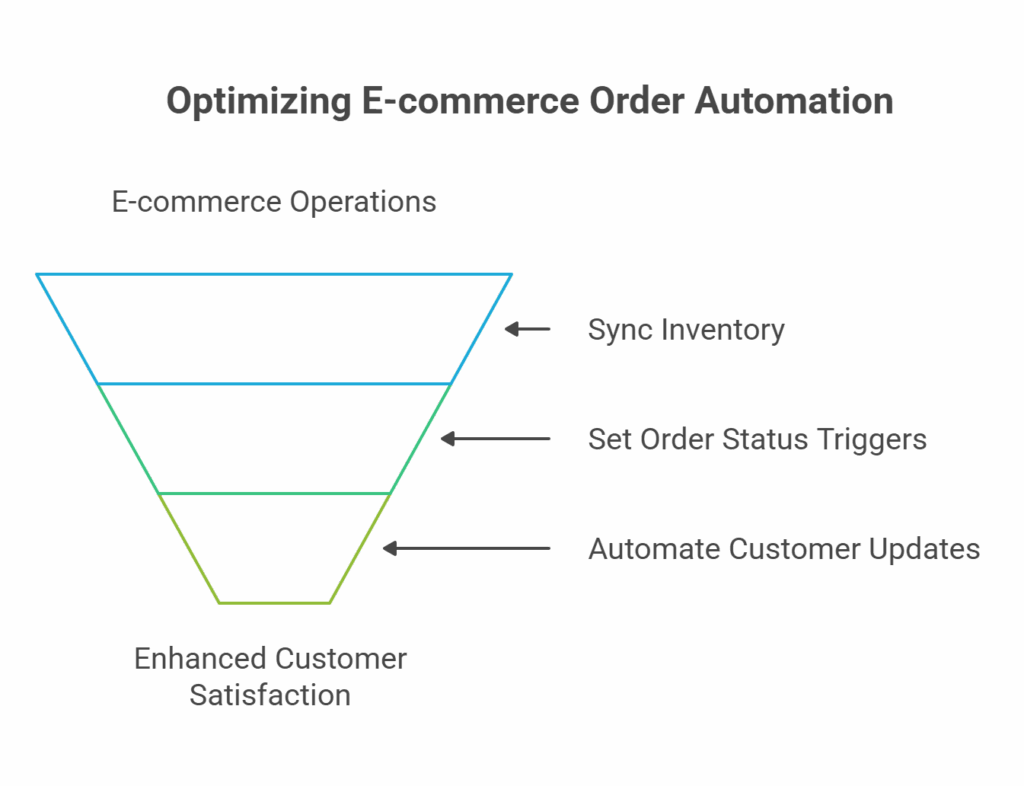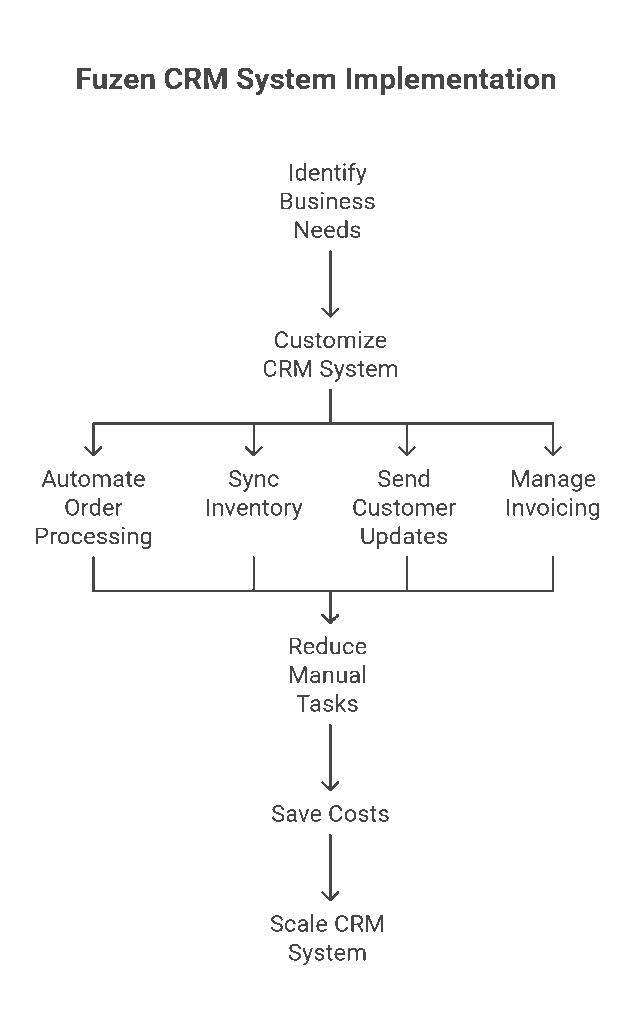Managing orders manually can quickly become a burden as your business grows and the volume of orders increases. This leads to longer wait times and frustrated customers. Manual workflows also raise the chances of sending the wrong items or missing critical inventory updates, which can harm both your reputation and customer satisfaction
These small mistakes have big consequences. Poor customer experiences, such as late deliveries or incorrect shipments, can cause even loyal buyers to switch to competitors. In e-commerce, customers value speed, accuracy, and real-time updates.
By adopting automation tools, businesses can transform their operations. Instead of being bogged down by routine tasks, teams can focus on improving service and scaling up. Let's look at some best practices for e-commerce order automation.
The Power of Automation and CRM Integration
Automation in order management is a game changer. It becomes even more powerful when paired with a strong CRM system. Together, they can transform how e-commerce businesses handle transactions.
With automation, routine tasks are handled automatically. This means fewer manual errors and faster processing. Imagine a system where orders move from confirmation to delivery without manual input.
One of the e-commerce order automation best practices is integrating your CRM system. CRM keeps all your customer data in one place. You can track order history, preferences, and communication with ease.
When CRM is connected to your automation tools, it creates a smooth flow of information. Customers receive real-time updates about their orders without anyone having to send them manually.
This setup also improves customer communication. Automated emails or messages can update customers about shipping, delivery estimates, or order changes. It creates transparency and builds trust.
Another key advantage is personalization. Your CRM can use past data to customize messages. This makes customers feel recognized and appreciated, increasing the chances of repeat purchases.
By adopting e-commerce order automation best practices, businesses reduce errors, save time, and provide a better customer experience. It's a smart step toward more efficient and scalable operations.
Best Practices for Order Automation
Efficient order automation is all about using smart strategies to optimize your e-commerce operations and improve customer satisfaction. Here are some of the e-commerce order automation best practices to help you get started:
Sync Inventory in Real Time
Keeping your inventory updated across all platforms is essential. Real-time syncing ensures your online store displays accurate stock levels. This prevents overselling, where customers order items that are out of stock, and underselling, where available products go unnoticed. Reliable inventory information builds customer trust and keeps your order process smooth.
Set Up Order Status Triggers
Triggers automatically update order statuses at every stage of the process—from order confirmation to shipping and final delivery. This not only speeds up the workflow but also ensures customers receive timely updates. When customers know what’s happening with their order, it adds transparency and helps build confidence in your service.
Automate Customer Updates and Invoicing
Customers expect prompt communication. Automating order updates and invoice generation ensures they receive timely notifications and records after every purchase. This adds professionalism to your business and improves the overall experience. Clear communication also reduces the chance of customer complaints or confusion.
Applying these e-commerce order automation best practices will help you reduce manual errors, streamline your process, and create a more reliable experience for your customers. With the right tools, your order management can run smoothly while freeing up your team to focus on growing the business.
Real Scenarios Where Automation Saves Time and Reduces Cancellations
Seeing automation in action helps illustrate its real-world value. Below are examples that highlight how e-commerce order automation best practices bring measurable improvements to online businesses.
Faster Order Processing
An online retailer faced delays during peak shopping seasons due to manual order handling. After switching to an automated system, they saw a major improvement in processing speed. Orders were confirmed instantly, and picking lists were auto-generated for warehouse staff. This reduced turnaround time and ensured that customers received their packages quickly, leading to greater satisfaction and more repeat purchases.
Fewer Data Entry Errors
One business struggled with manual data entry, often inputting incorrect customer details. This caused problems like wrong shipments and a high rate of returns. Automation solved this by pulling customer data directly from online orders, cutting out human error. As a result, the business experienced fewer mistakes and a notable drop in returns, while customer trust improved.
Better Customer Communication
A fashion brand used automation to send SMS and email updates at every step of the order journey. Customers received timely messages confirming their orders, shipping details, and delivery updates. This reduced uncertainty and led to fewer support queries and cancellations. Customers appreciated the clear communication, which helped the brand boost satisfaction and loyalty.
These examples show that e-commerce order automation best practices go beyond saving time. They improve accuracy, build trust, and help create a smoother experience for both businesses and customers. Automation makes it possible to scale operations while maintaining a high standard of service.
Building Custom CRMs with Fuzen for Automated Order Workflows
In today’s fast-moving e-commerce space, managing orders quickly and accurately is key to success. That’s where Fuzen comes in. It helps you build a custom CRM system without writing a single line of code. Whether you’re a small online store or a growing brand, Fuzen makes it easy to automate and manage your order workflows in a way that fits your business perfectly.
Fuzen’s no-code platform is designed for non-tech users. You can set up and customize your CRM using simple drag-and-drop tools or even describe what you need in plain language. Fuzen’s AI features take care of the rest—creating smart workflows and automations tailored to your needs.
You can automate:
- Order processing, so every new order moves through your system without delays
- Inventory syncing, to avoid overselling and keep stock levels accurate
- Customer updates, such as order confirmations and delivery alerts
- Invoicing and follow-ups, without lifting a finger
Fuzen also comes with pre-built CRM templates that you can use right away and customize as your business grows. You can adjust workflows, add new features, or change how your CRM functions—without depending on developers.
Another major advantage is cost. With Fuzen, you avoid expensive subscriptions. You pay a one-time hosting fee, which makes it ideal for businesses looking to cut software expenses. In fact, users save up to 80% compared to traditional development costs.
This approach aligns perfectly with custom CRM cost development, giving businesses the flexibility to build tailored CRM systems without overspending. Fuzen enables you to scale affordably while maintaining full control over your features and data.
Plus, Fuzen’s platform is scalable. That means your CRM grows with your business. If your orders double or your operations expand, your system can adapt easily—no rebuilds or major changes needed.
In short, Fuzen helps e-commerce brands manage orders more efficiently, with tools for workflow automation, lead management, CRM building, and more—all built around your real needs. It’s the smarter way to run your back-end operations without getting stuck in tech complexity or high costs.
Conclusion
Order automation is essential for improving speed, accuracy, and customer satisfaction in e-commerce. By following e-commerce order automation best practices, businesses can reduce manual errors, save time, and offer faster service.
Fuzen helps you build a custom CRM that automates your entire order workflow—without any coding. Its no-code tools and AI features make it easy to set up automation for inventory syncing, customer updates, and order processing.
You save on high development costs and avoid ongoing subscription fees. Fuzen gives you full control to scale and customize your CRM as your business grows.
Ready to streamline your e-commerce operations? Start building your automated CRM with Fuzen today.

Pushkar is a seasoned SaaS entrepreneur. A graduate from IIT Bombay, Pushkar has been building and scaling SaaS / micro SaaS ventures since early 2010s. When he witnesses the struggle of non technical micro SaaS entrepreneurs first hand, he decided to build Fuzen as a nocode solution to help these micro SaaS builders.



